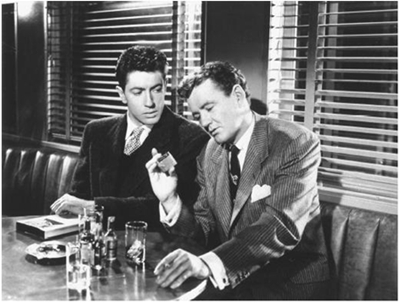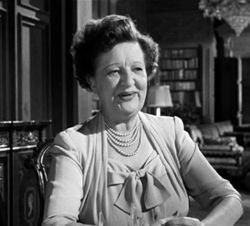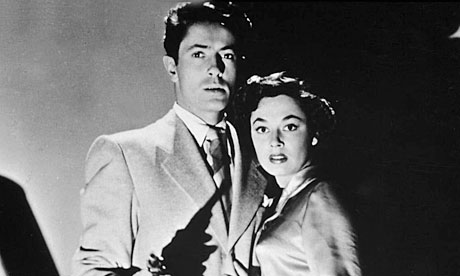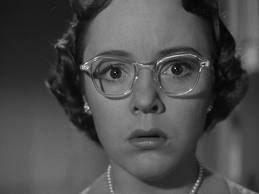Strangers on a Train/1951/Warner Bros. Pictures/101 min.
A friend of mine once went on a second date with a guy who showed up wearing saddle shoes. Let’s just say there wasn’t a third date. If only he’d seen 1951’s “Strangers on a Train.” Alfred Hitchcock understood the importance of footwear and it shows in this stellar film.
He starts the story by contrasting the shiny, two-toned spats of Bruno Anthony (Robert Walker) with the sensible black dress shoes of Guy Haines (Farley Granger) as each emerges from a Diamond cab. We follow these parallel footsteps as they board the same train, hence the title.
These brief shots contain the crux of the film: Model citizens often hide hard-core badness and the most unsavory renegades and reprobates can surprise you with a virtue or two (especially if we count charm and fashion sense as virtues).
Despite their differences, Bruno and Guy both have monkeys on their backs. Bruno is a spiffy playboy with psychopathic tendencies. Besides drinking and gambling, he spends his time hatching schemes for space travel and blowing up the White House. Even though Bruno has his wealthy and wacky mother (Marion Lorne) wrapped around his little finger, his father (Jonathan Hale) isn’t so flexible. In fact, he keeps threatening to have Bruno “taken care of, if necessary, put under restraint.”
Guy is a pro tennis player who wants to marry his dream girl Anne Morton (Ruth Roman), daughter of Senator Morton (Leo G. Carroll). Hitch’s daughter Patricia plays Anne’s little sister, Barbara. Unluckily for Guy, he’s already married to venal and unfaithful Miriam (Kasey Rogers, credited as Laura Elliott).
So, during their train trip, Bruno strikes up a conversation with Guy, telling him: “I certainly admire people who do things.” Over drinks, smokes and a lamb-chop lunch, Bruno proposes a daring, if absurd, solution to both of their glitches: If Bruno murders Miriam, that would leave Guy free to marry Anne. In exchange, Guy would bump off Mr. Anthony. Guy laughs it off, but Bruno takes it as mutual pledge and proceeds to carry out his part of the deal, trailing Miriam to a carnival and murdering her.
When he hears the news, Guy’s shocked, but if he tells the police, Bruno will claim that Guy was an accomplice. Besides, he had motive. As the police investigate, Bruno pressures Guy to fulfill his part of the plan.
Guy resists, but Bruno won’t back down and turns into a bit of a stalker. Bruno also has an ace in the hole: he nabbed Guy’s engraved cigarette lighter when Guy left it behind after their lunch on the train. Guy may lack Bruno’s warped brilliance but he pushes back when cornered and he’s determined to set things right.
If you don’t love “Strangers on the Train,” I’ll be shocked. It’s a gloriously suspenseful story, based on a Patricia Highsmith novel. Raymond Chandler wrote the screenplay, but most of that was trashed and rewritten by Czenzi Ormonde, with uncredited help from Ben Hecht. (Whitfield Cook adapted.) Hitch and Chandler apparently had a hate/hate relationship.
It also exemplifies the power of visual storytelling. Hitchcock makes us feel Guy’s anxiety with stunningly composed shots that remind us: Bruno is not going away. He also signifies a sense of entrapment with the latticework lighting patterns, which I think are some of the most exquisite in all of cinema.
Hitchcock builds tension by putting Bruno and Guy’s characters in sharp relief. One way he does this by cross-cutting between their two situations, most famously between Guy rushing through a tennis game, and Bruno frantically trying to retrieve Guy’s lighter after it falls into a street drain.
The performances in this movie are terrific. Walker captures the reckless rich-boy abandon that stems from longtime overindulgence and ennui. To say Bruno has faults is like saying a forest has a tree or two. Yet, somehow, we find ourselves almost liking Bruno, demented as he is. Probably most challenging for Walker was the fact that Bruno is strongly attracted, perhaps in love, with Guy and Walker incorporates this into his portrayal with subtlety and intelligence.
Off-screen, Walker was married to the stunningly beautiful actress Jennifer Jones, but their marriage crumbled when legendary producer David O. Selznick entered their lives. Selznick helped both of their careers, but Jones fell in love with the powerful Selznick and left Walker.
Eight months after “Strangers” wrapped, Walker, 32, died of an allergic reaction to a prescription drug. Walker and Jones had two sons, Robert Walker, Jr. and Michael Walker, who also became actors.
Granger more than holds his own as the upstanding, wholesome athlete and is the perfect foil to Walker. Roman, as Guy’s patrician girlfriend, is wonderful as is Pat Hitchcock as the adorable and cheeky Barbara; Lorne is spectacular as Bruno’s dotty mother. She later played air-headed Aunt Clara on the TV show “Bewitched.”
Despite the wonderful performances, “Strangers” was snubbed by the Academy. “An American in Paris” won the Oscar for best movie that year; other contenders were: “Decision Before Dawn,” “A Place in the Sun,” “Quo Vadis,” and “A Streetcar Named Desire.” Humphrey Bogart took home the best actor Oscar for “The African Queen.” Karl Malden won best supporting actor for “Streetcar.”
“Strangers” was the kind of movie the Academy typically snubbed and of course in the U.S. Hitchcock didn’t get the full respect he deserved until the late ’60s. (In the late ’50s, French critics acknowledged his genius.) Better late than never I guess.
And speaking of recognizing a gem, remember my friend with the saddle-shoes dude? Well, I fibbed. After an emergency intervention with a personal shopper and extensive counseling, they went on several more dates and ended up married with four kids.
Such is the life-changing force of Ferragamo.














From FNB readers